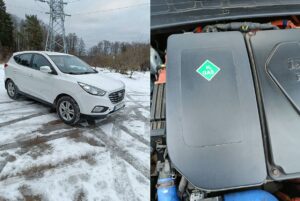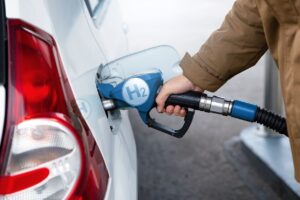At the moment, there are only two hydrogen cars in Lithuania so far. One of them is owned by Benas Gabrielis Urbonavičius, associate professor from Faculty of Mathematics and Natural Sciences at Kaunas University of Technology (KTU). For him, however, it is more of a toy than a proper vehicle, he says, since filling up requires a trip to Riga.
Benas Gabrielis Urbonavičius, an associate professor at the KTU FMNS Department of Physics, tells that he bought the hydrogen-powered Hyundai ix35 a little over a month ago, mostly out of curiosity. 
“Since we have a tradition of researching hydrogen technology in the Department of Physics in Kaunas, I have always wanted to buy this car and, in the end, I managed to do it,” he says.
As a physicist, Urbonavičius says he is interested in the technology which still sounds novel and fascinating. “You take the user’s manual and it says: Check that the proton membrane sensors are working properly. That really catches your attention,” he says.
Urbonavičius bought the vehicle at a second-hand car market in Marijampolė and paid “a really cheap price” of 4,000 euros.
“Obviously, there were some technical problems that had to be fixed, it was defective. But actually it depreciated very quickly. The car was made in 2016. New ones cost about 80,000,” the academic notes.
This rapid fall in price, he explains, is due to the fact that hydrogen cars are difficult to fill. There are no hydrogen filling stations in Lithuania yet, so Urbonavičius has to travel to Riga each time. Because of these limitations, he has not yet given up his regular car.
“Unfortunately, it is not feasible to use it as your only car because of hydrogen refuelling, which currently you can do only in Riga. It would just be very inconvenient,” he says, adding that he has to transport his car to Latvia on a trailer.
Interestingly, says Urbonavičius, there does not appear to be any hydrogen cars in Latvia, only a filling station.
Safety first
The scientist explains that hydrogen in his car is stored in two tanks at a pressure of 700 bar. In total, they can hold over 5 kilograms of hydrogen, enough to drive around 500 kilometres.
“One kilo in Riga costs almost 16 euros, the price hasn’t changed for a long time. So, on balance, it’s more expensive than driving an internal combustion engine,” says Urbonavičius.
Asked how it feels driving a hydrogen car, he says the experience is similar to driving an electric car.
“The torque is there all at once, like an electric motor – between 100 and 130 kW, depending on the car. Mine has 100 kW. It’s not very fast, but it’s definitely enough in the city, it works very well,” he enthuses.
He is also satisfied with the safety of his new vehicle, despite the fact that hydrogen is highly combustible.
“The biggest issue, of course, is the hydrogen tanks. Their safety standards are very strict. Moreover, if, for example, a car is involved in an accident and the rear end of the car, where the tanks are located, is severely damaged, there is a special system that dumps the end of the tank and
ignites the hydrogen so that it burns to the ground, doesn’t inflame anything else around it,” says Urbonavičius.
Car for teaching
Given the limited possibilities to drive the new car wherever he wants, Urbonavičius thinks of it as a teaching devise.
“This is a technology that is being talked about a lot at the European level, and there are certain developments in Lithuania. It is also important for our students to know what it is all about, whether it does or does not succeed on a large scale.
“We are even thinking that this autumn we will have a laboratory for students in the Department of Physics at KTU FMNS where they can study these technologies,” says Urbonavičius.
As he explains, hydrogen does not exist in nature in its pure form, its production requires a lot of energy. One way, the most common one, is making hydrogen from natural gas. However, the process also produces CO2 gas, which is a pollutant.
There is a more environmentally friendly form of fuel, green hydrogen, which is produced from water, Urbonavičius adds.
“We can produce hydrogen by splitting water using renewable energy. Let’s say we have a solar farm, a wind farm, where we are already producing electricity without pollution. Then we use it to produce hydrogen from water,” says Urbonavičius.
He hopes that one day hydrogen-powered cars in Lithuania will be driven as widely as electric cars today.
“This requires really big investments. Clearly, it is up to our politicians to decide which way to go. It seems cheaper to go down the road of electric cars now, but for commercial transport, perhaps hydrogen could be the solution of the future,” says the KTU FMNS associate professor.
Source of the article: https://tinyurl.com/mta88b3j